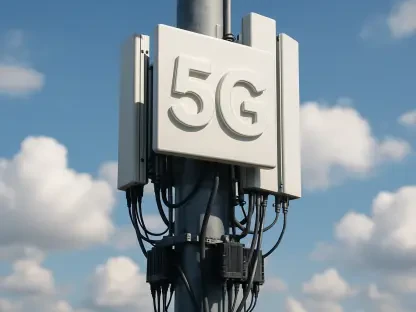In an era where seamless connectivity is no longer a luxury but a necessity for businesses, the enterprise Wireless Local Area Network (WLAN) market stands on the brink of a transformative shift, propelled by the rapid emergence of Wi-Fi 7. This latest wireless standard, known technically as 802.11be, promises to redefine network performance with unprecedented speed and efficiency, catering to the escalating demands of modern enterprises. As companies increasingly rely on digital infrastructure to support remote work, cloud services, and data-intensive applications, the need for robust WLAN solutions has never been more critical. Forecasts indicate a remarkable revenue growth of 12 percent in the current year for the WLAN market, following the resolution of inventory backlogs in distribution channels. This surge sets a strong foundation for the adoption of advanced technologies, with Wi-Fi 7 poised to play a pivotal role in driving innovation and meeting the connectivity challenges faced by businesses through the end of this decade.
The Catalysts Behind Wi-Fi 7’s Market Dominance
One of the primary forces accelerating the rise of Wi-Fi 7 in the enterprise WLAN sector is its projected market penetration, expected to account for over a third of Indoor Access Point (AP) revenues in the near term. By 2028, this technology is anticipated to dominate, representing more than 90 percent of such revenues—a level of adoption that surpasses its predecessor, Wi-Fi 6, largely due to the rapid introduction of Wi-Fi 6E with its 6 GHz band capabilities. The reduced price premiums associated with Wi-Fi 7 further enhance its appeal, making it a cost-effective option for enterprises aiming to upgrade their networks. Beyond pricing, the integration of Artificial Intelligence (AI) in business operations is placing heightened demands on local networks, necessitating investments in cutting-edge WLAN infrastructure. Additionally, evolving market dynamics, such as strategic acquisitions and the shift toward subscription-based software models with growing Annual Recurring Revenue (ARR), are fostering a competitive and innovative landscape that supports the swift uptake of this transformative wireless standard.
Looking back, the trajectory of Wi-Fi 7’s adoption reflects a market eager to embrace technological advancements that address real-world enterprise needs. The groundwork laid by industry leaders and standards bodies paved the way for a seamless transition from earlier standards, ensuring that businesses could adapt without significant disruption. As attention turns toward future innovations like Wi-Fi 8, expected to emerge by late 2028, the focus remains on sustaining this momentum. Enterprises are encouraged to assess their current network capabilities and plan strategic upgrades to leverage the full potential of Wi-Fi 7 in the intervening years. Collaborating with technology providers to integrate scalable, cloud-managed solutions has become a recommended step, alongside preparing for the increased network demands driven by AI and other emerging trends. These proactive measures promise to position businesses at the forefront of connectivity advancements, ensuring resilience and competitiveness in an ever-evolving digital landscape.









